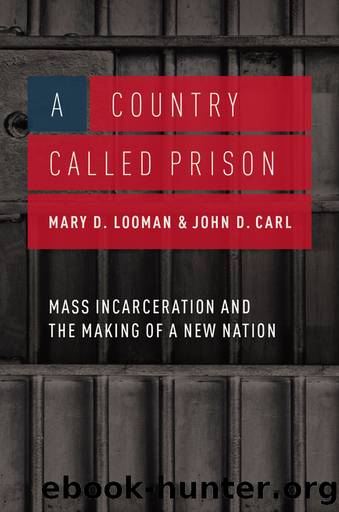A Country Called Prison by Looman Mary D.;Carl John D.;Carl John D.;

Author:Looman, Mary D.;Carl, John D.;Carl, John D.; [Looman, Mary D.;Carl, John D.;Carl, John D.;]
Language: eng
Format: epub
ISBN: 9780190211035
Publisher: OxfordUP
Published: 2015-09-15T00:00:00+00:00
In terms of helping offenders emigrate from the Country Called Prison, the most important part of Nowakâs Cooperation Instinct Theory is that cooperation does not require an institution to direct altruistic behavior. Cooperation is an instinct, an innate part of who we are. Correctional departments merely need to let it flourish.
The computer-animated movie Ice Age (Wedge et al., 2002) provides the perfect metaphor for Nowakâs theory, as well as the situation America finds herself in, with latent consequences of mass incarceration piling up. The story takes place during the end of the Ice Age, when animals had to migrate to survive. The storyâs main characters are three prehistoric animalsâa sloth, a mammoth, and a saber-tooth tigerâwho are natural enemies. At first the annoying and pathetic sloth joins with the depressed and irritable mammoth. The mammoth is sad because human hunters killed his wife and child. Upon the slothâs insistence, they rescue an infant human boy from a riverbank as the mother drowns. Soon the devious tiger joins the team; heâs been ordered by his herd to lead the heroes into a trap so the baby can be killed and eaten.
Along the way, the three animals must cooperate with each other in order to survive. A friendship begins to emerge, and each of their personalities becomes more affable and gracious. The pathetic sloth assumes responsibility and develops courage. The mammoth overcomes his grief and self-centeredness in order to save the child, who may grow up to hunt mammoths. The tiger learns to think for himself, rather than taking orders from his leader; he becomes willing to give up his life to save his new herd. In the end, the baby is returned to the humans, and the three natural enemies create their own herd based on friendship and altruism.
Just as the great glaciers of Earthâs Ice Age melted so that land could be formed and humans could eventually populate the Earth, the mass incarceration mountain has to melt away. We have to migrate away from a belief system that causes us to see enemies where there are none. We need to create prison environments that encourage cooperation and altruistic behavior, that help people self-actualize, to become what they are innately capable of. A human is a terrible thing to waste.
We recognize that prison culture has evolved over many years and will be difficult to change. However, if we want people to leave prison and never return, then we must try. Changing a culture requires not only new rules and regulations but new psychological and social acuities, which are hardest to acquire. Therefore, the proposals that follow are intended to only get the ball rolling. Our hope is that as small changes take place and life within prison becomes more psychologically healthy for everyone, people will be motivated to try more healthy ideas until we have a society that more closely resembles the egalitarian America we all want to live in. Once again, our proposals are focused on the nonviolent offender population. You can also find these listed in the action plan found in the appendix.
Download
This site does not store any files on its server. We only index and link to content provided by other sites. Please contact the content providers to delete copyright contents if any and email us, we'll remove relevant links or contents immediately.
The 1921 Tulsa Race Massacre by Chris M. Messer(287)
Introduction to Criminal Justice - A Balanced Approach by Brian K. Payne Willard M. Oliver Nancy E. Marion(254)
Russia's Sakhalin Penal Colony, 1849â1917 by Andrew A. Gentes(249)
Punishing the Poor The Neoliberal Government of Social Insecurity by Unknown(249)
The History of Newgate Prison by Jowett Caroline;(236)
Serial Killers America and UK - 2 BOOKS IN 1 by Clark Matthew(210)
A History of Police and Masculinities, 1700-2010 by David G. Barrie Susan Broomhall(195)
Restorative Justice in Transitional Settings by Kerry Clamp(168)
Organized Crime and Corruption Across Borders by T. Wing Lo Dina Siegel Sharon I Kwok(158)
Culture, Crime and Punishment by Ronald Kramer(155)
Cops, Cameras, and Crisis by Michael D. White Aili Malm(154)
Dangerousness, Risk and the Governance of Serious Sexual and Violent Offenders by Karen Harrison(153)
Policing Gender, Class And Family In Britain, 1800-1945 by Linda Mahood(152)
Routledge Handbook on Immigration and Crime by Holly Ventura Miller Anthony Peguero(151)
The Real CSI by Kate Bendelow(149)
Women Exiting Prison by Bree Carlton Marie Segrave(142)
Losing Legitimacy by Gary Lafree(138)
Using Murder by Philip Jenkins(136)
A Theory of African American Offending by James D. Unnever Shaun L. Gabbidon(135)
